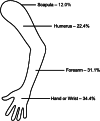The Epidemiology, Management, and Outcomes of Civilian Gunshot Wounds to the Upper Extremity at an Urban Trauma Center
- PMID: 38633511
- PMCID: PMC11023610
- DOI: 10.1097/GOX.0000000000005753
The Epidemiology, Management, and Outcomes of Civilian Gunshot Wounds to the Upper Extremity at an Urban Trauma Center
Abstract
Background: Gunshot wounds (GSWs) create significant morbidity in the United States. Upper extremity (UE) GSWs are at high risk of combined injuries involving multiple organ systems and may require variable treatment strategies. This study details the epidemiology, management, and outcomes of civilian UE GSWs at an urban level 1 trauma center.
Methods: Using the University of Pennsylvania Trauma Registry, all adult patients with UE GSWs from 2015 to 2020 who were at least 6-months postinjury were studied for demographics, injury pattern, operative details, and postoperative outcomes. Fisher exact and Wilcoxon rank sum tests were used to determine differences in treatment modalities and outcomes.
Results: In 360 patients, the most common victim was young (x̄ = 29.5 y old), African American (89.4%), male (94.2%), and had multiple GSWs (70.3%). Soft tissue-only trauma (47.8%) and fractures (44.7%) predominated. Presence of fracture was independently predictive of neurologic, vascular, and tendinous injuries (P < 0.001). Most soft tissue-only injuries were managed nonoperatively (162/173), whereas fractures frequently required operative intervention (115 of 161, P < 0.001). Despite a prevalence of comminuted (84.6%) and open (43.6%) fractures, hardware complications (7.5%) and wound infection (1.1%) occurred infrequently.
Conclusions: Civilian GSWs to the UE with only soft tissue involvement can often be managed conservatively with antibiotic administration, bedside washout, and local wound care. Even with combined injuries and open fractures, single-stage operative debridement and fracture care with primary or secondary closure often prevail. As civilian ballistic trauma becomes more frequent in the United States, these data help inform patient expectations and guide management.
Copyright © 2024 The Authors. Published by Wolters Kluwer Health, Inc. on behalf of The American Society of Plastic Surgeons.
Conflict of interest statement
The authors have no financial interest to declare in relation to the content of this article.
Figures





Similar articles
-
The Orthopaedic Burden of Gun-shot Injury in Children: A Single-Institution Analysis.J Pediatr Soc North Am. 2024 Sep 14;9:100117. doi: 10.1016/j.jposna.2024.100117. eCollection 2024 Nov. J Pediatr Soc North Am. 2024. PMID: 40432672 Free PMC article.
-
Outcomes of complex gunshot wounds to the hand and wrist: a 10-year level I urban trauma center experience.Ann Plast Surg. 2012 Apr;68(4):374-7. doi: 10.1097/SAP.0b013e31823d2ca1. Ann Plast Surg. 2012. PMID: 22421482
-
How Do Gunshot and Explosive Injuries to the Lower Extremities Differ in Severity and Treatment? A Comparative Study From the Israel-Gaza Conflict.Clin Orthop Relat Res. 2025 Apr 15. doi: 10.1097/CORR.0000000000003498. Online ahead of print. Clin Orthop Relat Res. 2025. PMID: 40258172
-
Surgical Treatment of Upper Extremity Gunshot Injures: An Updated Review.Ann Plast Surg. 2021 Mar 1;86(3S Suppl 2):S312-S318. doi: 10.1097/SAP.0000000000002634. Ann Plast Surg. 2021. PMID: 33346543 Review.
-
Upper Extremity Ballistic Nerve Injury: A Scoping Review and Algorithm for Management.JBJS Rev. 2024 Aug 5;12(8). doi: 10.2106/JBJS.RVW.24.00069. eCollection 2024 Aug 1. JBJS Rev. 2024. PMID: 39297773
References
-
- Westervelt E. The toll of America’s gun violence epidemic. All Things Considered. Available at https://www.npr.org/2022/07/20/1112579563/the-toll-of-americas-gun-viole.... Published July 20, 2022. Accessed September 8, 2022.
-
- Robertson C. As shootings soar in Philadelphia, city is awash in guns. The New York Times. Available at https://www.nytimes.com/2022/08/11/us/philadelphia-gun-violence-shooting.... Accessed September 8, 2022.
-
- Kalesan B, Adhikarla C, Pressley JC, et al. . The hidden epidemic of firearm injury: increasing firearm injury rates during 2001-2013. Am J Epidemiol. 2017;185:546–553. - PubMed
-
- United States Department of Health and Human Services. Centers for Disease Control and Prevention. National Center for Injury Prevention and Control. Firearm injury surveillance study, 1993-2020: version 1. 2022.
LinkOut - more resources
Full Text Sources
Research Materials
